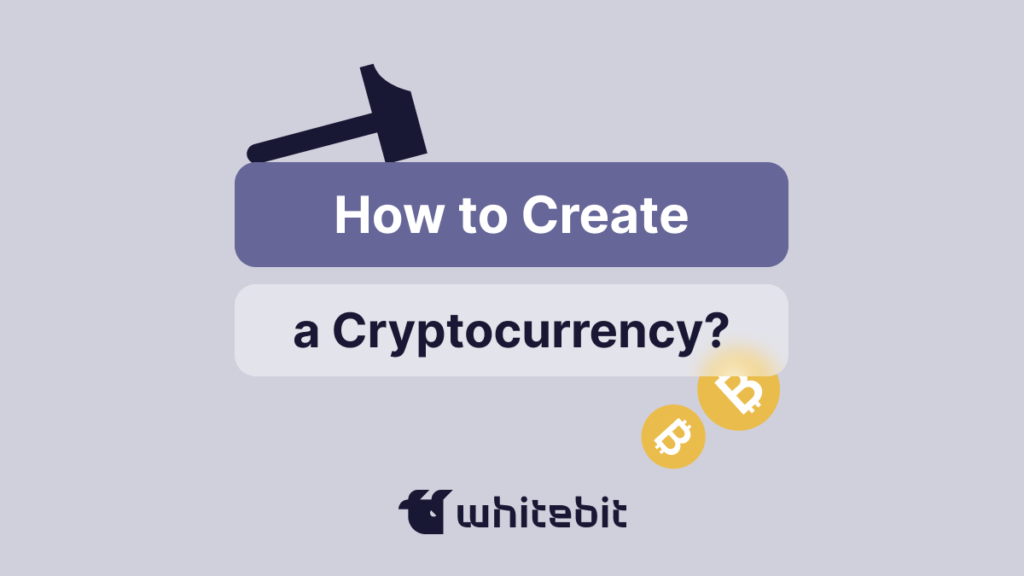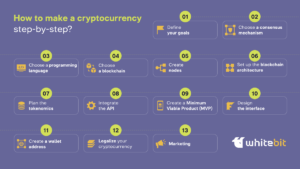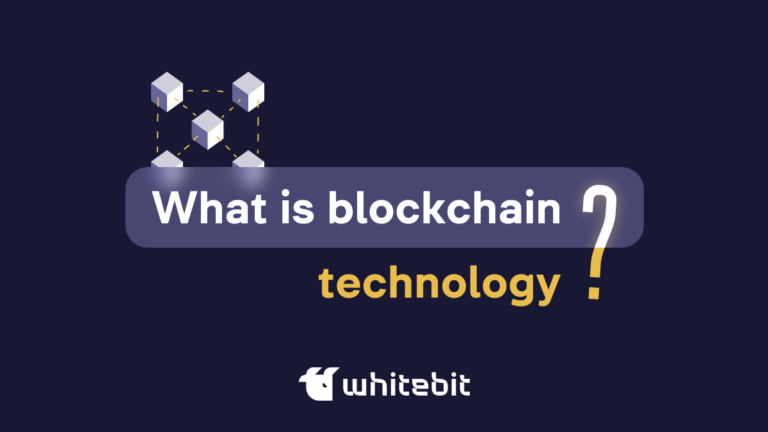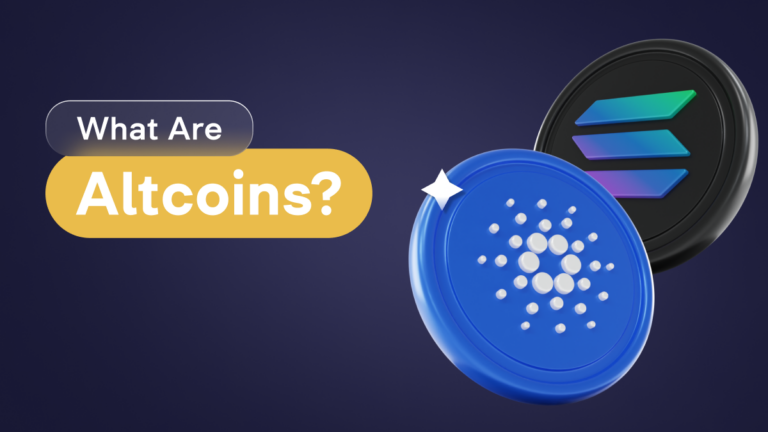How to Create a Cryptocurrency?

Content
If inspired by the success of cryptocurrencies, you are thinking about creating your token but need help knowing where to start — our article is just for you!
What is cryptocurrency?
Cryptocurrencies are digital currencies that use an encryption method (cryptography) as a means of transaction security. A network of decentralized computer nodes provides their work. Most cryptocurrencies operate based on the blockchain. It is a database of transactions in a chain of related blocks.
As a rule, cryptocurrencies are used to store funds, pay the transfer fee and make settlements between network users. Read more about virtual assets in our article “What is cryptocurrency”.
Token vs. coin
Before answering the question of how to make a cryptocurrency coin, we need to differentiate these two terms.In the crypto industry, the concepts of “coin” and “token” are often confused or used as synonyms. They are different things.
The coins are designed from the ground up to function as a currency and are built on their blockchain. They are a form of transaction and function similarly to government currency. Coins with their blockchain include Bitcoin, Ethereum, XRP, Tezos, EOS, Solana, and many others.
Tokens are cryptocurrencies that do not have their blockchain and operate based on another network. Tokens are issued thanks to smart contracts, which became popular after the launch of Ethereum. The most popular token standard is the Ethereum-based ERC-20. Learn more about the process of creating tokens in the article “How to create a token”.
Ways to create cryptocurrency
Create your blockchain
It is the best option to create a cryptocurrency with minimal effort. For example, the popular Shiba Inu (SHIB) asset is built on the Ethereum blockchain.
Fork an existing blockchain
You can also make cryptocurrency by changing the existing blockchain source code. That is, to create a so-called fork.
A fork creates cryptocurrency based on the old blockchain. This method requires great effort and specific technical knowledge. Fortunately, the most popular blockchains, including Bitcoin, Ethereum, Polkadot, Solana, and EOS, are open-source and readily available on GitHub.
Thanks to hard forks, developers get rid of the shortcomings of the blockchain.
For example, the Bitcoin network processes transactions slowly, has high transfer fees and do not guarantee anonymity. Because of this, Bitcoin suffered six hard forks in 2017. As a result of the network split, Bitcoin Cash, Bitcoin Gold, Bitcoin Diamond, and other analogs appeared.
Use an existing platform
Another option is to create your blockchain and develop a coin based on it. It gives more flexibility and total control over the coin. However, it requires considerable technical skills in the development and an investment of time and money.
How to make a cryptocurrency step-by-step?
Step 1. Define your goals
Why do you want to create a cryptocurrency? What tasks will she perform? Before starting development, define the functions of the asset. Then move on to choosing a name and designing a logo — they will help your token stand out from thousands of others.
It is followed by creating a White paper — an official document containing all the basic information about the new blockchain project and its goals of solving problems in the industry.
The White Paper is becoming something between technical documentation and a marketing tool. A company often releases a white paper before raising funds through an ICO/IEO/IDO to tell potential investors about their product.
On the 31st of October 2008, Satoshi Nakamoto released the Bitcoin White Paper, laying out the essence of the project in 10 pages. It differs from many contemporary counterparts and more closely resembles an academic publication.
Step 2. Choose a consensus mechanism
The consensus mechanism is a set of principles and rules, thanks to which all nodes (nodes) participating in the network automatically come to a consensus on the current state of the network. The two most common mechanisms are Proof-of-Work (PoW) and Proof-of-Stake (PoS).
PoW is the first cryptocurrency consensus mechanism based on proof of work. Such work is the search for a solution to a complex mathematical problem during mining. The essence of the concept is reduced to two rules:
- The need to perform a long and complex task with powerful equipment;
- The ability to easily check its result.
However, the PoW consensus mechanism has been heavily criticized due to its high-power consumption and associated environmental burden. Therefore, mechanisms that are less demanding on computing resources have appeared. One of them is PoS.
According to the PoS concept, all participants have the right to manage the blockchain by the number of assets they own. PoS outperforms PoW due to low-energy consumption for block generation and blockchain security. According to this principle, the more coins a user has, the higher his chance of receiving a reward for a new block. In addition, in the case of PoS, there is no need to buy expensive mining equipment.
At the same time, the PoS algorithm has a drawback — it encourages users to accumulate more coins. So, the system may lose decentralization, and most of the coins may end up with a few participants who can decide on the network for their interests.
You can also consider other options — for example, Proof-of-Authority (PoA) or Proof-of-Burn (PoB) algorithms.
Step 3. Choose a programming language
To create your cryptocurrency, you should choose a programming language. The choice of programming language depends on the desired characteristics and functions. The choice should be given to a widely supported language with an active community. As a rule, Solidity, C ++, Java, Python, Rust, or Substrate are chosen for these purposes.
Solidity is one of the most popular programming languages for writing smart contracts and dapps based on Ethereum. To get started with Solidity, you also need development experience in other languages: JavaScript, C++, and Python. To a large extent, Solidity was based on the concept of these languages.
Lately, the crypto industry has seen a significant increase in Rust programmers who have inherited the best from OCaml-like and functional languages. Thanks to Rust, projects such as Solana, Near, Compound and many other large projects that have already proven themselves have been launched.
Developers are also actively using the Substrate platform, built using the Rust programming language, to run projects in the Polkadot ecosystem.
This list can be continued for a long time, considering all the pros and cons of programming languages in various blockchains. Still, in any case, it already depends on your capabilities and knowledge.
Step 4. Choose a blockchain
Depending on the consensus mechanism chosen, you need to select a blockchain platform that supports it. For example, if you settled on the PoS algorithm, the Ethereum, Solana, Cardano, or Near blockchain will suit you.
Want to know how to create a crypto coin step-by-step? Then read on!
Step 5. Create nodes
The next step is downloading the required software and setting up the nodes. A node is a computer that has become a link in a decentralized network. The node computer is involved in verifying and relaying transactions and storing the history of transactions on the blockchain.
So, a computer turns into a node in the Bitcoin network after installing the Bitcoin Core blockchain. A node with a running “Bitcoin core” is called a full node. It validates blocks, confirms, or cancels transactions and transmits data over the network. Full nodes are independent of other nodes and maintain the stability of the blockchain.
Step 6. Set up the blockchain architecture
It’s time to plan the inner workings of your cryptocurrency infrastructure — transaction format, network protocol, and consensus algorithm. If you decide to build a cryptocurrency on an existing blockchain, you will benefit from its architecture. Most blockchains have an immutable, proven, decentralized cryptographic architecture.
Step 7. Plan the tokenomics
At this stage, it is necessary to plan cryptocurrency tokenomics. How many assets will be released? How many will be in circulation? Keep a balance. The cryptocurrency will have a lower value if too many assets are circulated.
Step 8. Integrate the API
API (Application Programming Interface) provides a communication channel between nodes in the network and helps make the software understandable to end users.
API integration plays a vital role in keeping your cryptocurrency secure and private. APIs also enable collaboration within the blockchain, especially when conducting transactions.
Step 9. Create a Minimum Viable Product (MVP)
MVP is a viable product with minimal but sufficient features to satisfy the first consumers. MVP will help detect product problems early while the minimum amount of time and money is still invested. Projects launch test nets to check the performance and network load and conduct a series of experiments that will not affect the real assets of users.
Step 10. Design the interface
A well-designed interface attracts new users and simplifies their interaction with the product. Cryptocurrencies are already a complex topic. Therefore, users choose a convenient and easy-to-navigate interface for their transactions.
Step 11. Create a wallet address
A wallet address is a unique sequence of letters and numbers associated with a particular cryptocurrency. You can create it using an online service or a program on your local computer.
Step 12. Legalize your cryptocurrency
Legality and regulations regarding cryptocurrencies vary by jurisdiction. Only issue an asset if you are in a crypto-friendly country. Also, determine if ICOs are allowed in your country before creating an ICO. In addition, in the White Paper, it is necessary to reflect on the legal aspects of the project.
Step 13. Marketing
To create buzz around the project launch, you should announce the airdrop on your official social media accounts or attract influencers to advertise.
Building a strong community through popular social networks, namely Discord, Telegram, Reddit, Medium, and Twitter, is necessary. Regular interaction and activity in social networks allow you to attract a much larger new audience to interact with the product and study the project. Therefore, it is always important to inform the audience about all plans, actions, and partnerships related to the project.
How much does it cost to make your cryptocurrency?
The cost of building a cryptocurrency varies depending on its type and your requirements. For example, developing a coin costs about $10,000–$30,000. As we said, they are considered more flexible and secure. In addition, a blockchain must be created for the coin. These factors make the development of this type of asset more expensive than the development of a token.
Creating a token will cost much less since you only need to develop and deploy a smart contract.
How long does it take to create a cryptocurrency?
Depending on the level of complexity, developing a cryptocurrency from scratch can take one to six months.
Building a base cryptocurrency using automated tools takes a few minutes. However, changing the existing blockchain code requires significant technical expertise.
Another issue is maintaining and promoting the coin since building your blockchain logic to launch it is necessary. Hiring experts will save time, but you must pay for software development.
Reasons for starting a cryptocurrency
- Project crowdfunding
If you need to fund a company at an early stage or want to start a crowdfunding campaign, issuing a cryptocurrency will be a means to attract investors.
- Financial flexibility
Cryptocurrencies are not controlled by centralized financial institutions such as central banks. Therefore, they give more flexibility. In addition, you can tailor the functionality of an asset to specific business operations.
For example, having your cryptocurrency can help you make faster payments at a lower cost than bank transfers if you are an international trader.
- Convenient payments
Having your own cryptocurrency gives you an edge over your competitors through increased efficiency and superior customer experience. It also provides an alternative to payments for customers worldwide, including unbanked users.
Three best cryptocurrencies in the market
Bitcoin (BTC)
Bitcoin is a digital asset and payment system implemented by Satoshi Nakamoto in 2009. Transactions are verified by network nodes using cryptography and recorded on a publicly distributed ledger called a blockchain.
Ethereum (ETH)
Ethereum is a cryptocurrency platform for building blockchain-based decentralized applications (dapps) using smart contracts. Its goal is to create a decentralized set of financial products that can be accessed by anyone in the world, regardless of nationality, ethnicity, or religion.
It makes the asset attractive because people who need government infrastructure can access bank accounts, loans, insurance, and various other financial products.
Tether (USDT)
Tether (USDT) is a 1:1 pegged token to the US dollar. Tether stablecoin is issued on several blockchains, such as Algorand, Ethereum, and Tron.
As one of the most popular stablecoins, Tether was created to protect cryptocurrency users from volatility.
FAQ
Usually, some programming knowledge is required to create a crypto coin or token. However, you can hire a developer to create a digital currency.
To create a token for free, you can use an app like WalletBuilders.
Yes, you need a license to develop a legal cryptocurrency. The conditions for obtaining it varies from country to country.
Yes, you can make your own cryptocurrency. However, this requires a certain amount of time and money.










